Untitled Document
The U.S. Military's Virtual Reality about a deadly day in May
Marc W. Herold
Department of Economics and Women's Studies
Whittemore School of Business & Economics
University of New Hampshire
A growing disconnect exists between the daily reality of war experienced by
the common Afghan and how this war is represented to the American general public
by the corporate media, many non-governmental organizations favoring "humanitarian
interventions" around the globe (e.g., Human Rights Watch), and the U.S.
military and its defense minions. The war in Afghanistan – as most other
wars beginning with Vietnam – is waged both on the ground there
and in the living rooms here. The recent midnight assault upon
the small village of Hajiyan (also called Alizi) along the Arghandab River in
Panjwayi District of Kandahar Province provides a case study to explore this
disconnect.1 No doubt many similar cases exist, but the U.S.
military media strategy to contain, isolate and stonewall succeeded there.
A very graphic way – a picture is worth a thousand words – is simply
to contrast photos of how the U.S. military is portrayed with Afghan children.
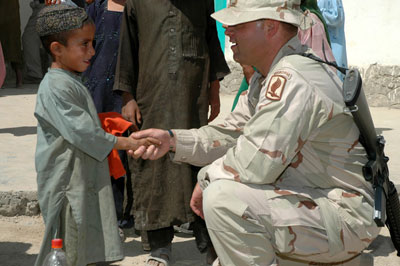
The above photo depicts U.S. Army Capt. John Pritchard of Combined Joint Task
Force 16 giving a tee-shirt to a young boy in Panjwayi. Another type of interaction
is shown in the following photo: the legacy of "precision fire" by
A-10 Warthog attack jets upon the village of Hajiyan in Panjwayi, revealed on
the body of three year-old Mohammad Imran (photo by Noor Khan, A.P.).

Both pictures are "true" and neither one alone represents reality.
Both illustrate two images of modern war: the war to win hearts and minds and
the war to kill the enemy. They are inseparable. But every effort will be made
to keep images like that of Imran off pages and screens of America because the
wars the U.S. carries out are represented as being the "good fights"
where only the bad guys die in a hail of "precision" bombs and rockets...
"in the rockets red glare."
On the other hand, the case of Imran was front-page news in the major national
daily of our neighbor to the north on May 23:
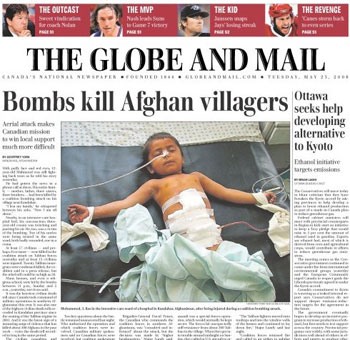
The district of Panjwayi along with neighboring Maywand has long been a stronghold
of the Taliban. Some of the first U.S. bombing attacks by the fearsome U.S.
flying gunship, the AC-130 (which was also involved in the attack
on the wedding in Kakarak on July 1, 2002) were carried out in the Panjwayi
district. On October 16, 2001, 8-9 Afghan civilians perished in such an attack
by an AC-130 when a home collapsed on its inhabitants.2 Two
months later, the Taliban surrendered Kandahar without a fight and dissipated
into the mountains and countryside, returning to their Pashtun villages like
in the Panjwayi district.
In five years very little has changed in the small mud brick villages of Panjwayi.
Hajiyan sill has no electricity and its water comes from a well. The village
comprises some 30-35 large mud brick compounds, each housing an extended family
of up to 50 persons. The district has been an area of continued intermittent
conflict between Taliban insurgents and U.S. occupation forces and their Afghan
allies. In April 2004, insurgents attacked the Afghan non-governmental organization,
Coordination of Humanitarian Assistance (CHA), killing two CHA workers and an
Afghan soldier. In October 2005, insurgents on motorcycles rode up to the Khanjakak
high school in the Panjwai district and gunned down the outspoken anti-Taliban
school headmaster in broad daylight in front of students. Hours later, gunmen
attacked a nearby primary school and shot dead a guard. The direct result of
such insurgent attacks was to close schools and to severely limit humanitarian
assistance, precisely the insurgents' intended outcome.3
Four years into the insurgency, public patience in Panjwayi District has largely
dissipated. The insurgency here (as elsewhere) is fed by frustration with a
corrupt and impotent Afghan government that has failed to improve the lives
of common people. The Christian Science Monitor reported recently that
villagers from Panjwayi say they are as frightened of the police who regularly
raid their homes and strip them of their meager valuables, as they are of the
Taliban militants.4
During the week before the massacre at Hajiyan, fierce fighting had erupted
in the Panjwayi District. The fighting broke out when Afghan and Canadian forces
went to the area based upon "information" that the Taliban had congregated
there. Unable to overcome the insurgents, tactical air support was called-in.
A Canadian soldier was killed along with three Afghan soldiers, six policemen
and at least three civilians.5
On Thursday, May 18 the U.S. military (typically an un-named general) and its
Afghan proxies in Kabul and Kandahar – in the guise of General Raufi who
heads up the Afghan military's southern region - loudly proclaimed the capture
of famed Taliban commander, Mullah Dadullah. The Afghan Army in search of success
was finally delivering results. The news headline was splashed across corporate
media outlets like the Associated Press and CBS News.6
Shortly thereafter, a Taliban spokesperson contacted the western media informing
it that he had just spoken with Mullah Dadullah who was somewhere in Kandahar
leading the insurgency and seemed in high spirits. But that news was not reported
or later prominently corrected, leaving the lingering impression that the fight
against the insurgents had scored another success. But, the headline had been
grabbed. The war as presented to those on the living room couch was making headway.
All the more so since the complicated and disturbing socio-economic realities
on the ground in Panjwayi district are never seriously explored.
The context above frames the way the midnight assault upon the village of
Hajiyan was constructed and represented to the American public. On Monday,
May 22, news headlines uncritically paraded the following,
"I can confirm there was a coalition air strike against a known Taliban
stronghold near the village of Azizi in the Panjwayi district and we believe
more than 50 Taliban have been killed in the operation," coalition spokesman
Major Scott Lundy told AFP.... The attack occurred late Sunday and early Monday
on the village of Azizi in Panjwayi district, Kandahar province, said a coalition
spokesman, Maj. Scott Lundy. "It was against a known Taliban stronghold
and we believe it resulted in about 50 Taliban killed," he said.
Some hours later, the U.S. military explained,
Air strikes were used to destroy a large enemy weapons cache and several
Taliban compounds.
Had injured Afghan civilians not been able to flee seeking medical care in nearby
Kandahar, the "news" would have stopped there. U.S. and their Afghan
proxy forces immediately close off all access to bombed sites as a means of
controlling information, that is, to manage what gets beamed to those on the
couch. In most instances, the mainstream American corporate media cooperates.
But the devastating aerial attacks by A-10 Warthog attack jets firing their
30 mn General Electric cannon (the size of a Volkswagen7) took
place between 11 P.M. and 5 A.M. and injured persons headed towards the hospitals
of Kandahar. A report in the Melbourne Herald Sun described the exodus,
"Bleeding and burnt children, women and men started arriving at Kandahar
hospital early yesterday. They were ferried by truck, taxi and minibus –
any vehicle that withstood the coalition bombardment of their village in southern
Afghanistan...only those who could find a working vehicle had been able to
make the 35 km journey to Kandahar for help, with many left behind...8
Given that injured Afghans and accompanying family members were talking to the
independent press like Reuters, Pajhwok Afghan News, and the Afghan Islamic
Press, damage control was needed. It was found with the governor of Kandahar,
a Karzai appointee, Asadullah Khalid, issuing a statement that 16 Afghan civilians
had also perished in the village of Azizi (sic). But the new "spin"
was all too obvious,
"These sort of accidents happen during fighting, especially when the
Taliban are hiding in homes," Kandahar Gov. Asadullah Khalid told reporters.
"I urge people not to give shelter to the Taliban."9
In other words, the American warplanes are exonerated and blame is put on
the very victims of the aerial attack. The governor, formerly governor of Ghazni,
is close to Afghan warlord and strongman Abdul al-Rasul Sayyaf and to the U.S.10
At that point, the news circulating worldwide admitted some civilian casualties
but a much larger number (80) of dead Taliban. Asadullah soon added during an
emergency press conference that he had received "intelligence reports"
that insurgents were hiding and meeting in the village. The U.S. jets attacked
the hideouts but the militants allegedly fled into a "populated area."
By noon Monday, the official story was being put in doubt as more independent-minded
reporters began interviewing injured villagers at Kandahar's Mir Wais hospital.
Saeed Zabuli of Pajhwok Afghan News filed a story, "Dozens Killed
as Coalition Planes Pound Areas in Kandahar," in which he names injured
civilians and quotes their stories. Nasrat Shoib of Agence France-Press
and Robert Birsel of Reuters soon add further graphic detail: Atta
Mohammad, a village elder, tells Shoib that 24 members of his family were killed
in the night time bombing; a wounded boy, Daad Mohammad, says to Birsel from
his hospital bed that all seven of his family members were killed. A Xinhua
News reporter also speaks with Atta Mohammad who says,
Over 50 people, 26 of them in one family...were killed in the bombardments
carried out by foreign aircraft and 17 wounded people including women and
children have been taken to Mir Wais hospital in Kandahar city...I could bring
10 seriously injured members of my family to the hospital."
Xinhua News also noted that Abdul Qayum Pukhla, head of the hospital,
confirmed the admission of 17 wounded persons into the hospital by Monday afternoon.
Further damage control was called-for. It appeared in a story filed by the
Associated Press' Noor Khan from Kandahar who cited an injured 40-year-old
man in the hospital, Haji Ikhlaf, who said insurgents had been hiding in the
Islamic madrassa religious school in the village after fierce fighting in recent
days, adding,
Helicopters bombed the madrassa and some of the Taliban ran from there into
people's homes. Then those homes were bombed...I saw 35 to 40 dead Taliban
and around 50 dead or wounded civilians.11
Khan also quoted another survivor from the village, Zurmina Bibi, who was cradling
her injured 8-month-old baby and said about 10 people were killed in her home
including 3-4 children. In Bibi's words,
There were dead people everywhere.
The ever-compliant governor of Kandahar, Asadullah Khalid added that the fleeing
Taliban "...used people's houses as their trenches. They (the 16 civilians)
were killed in the bombardment."
But Nasrat Shoib would soon sound another discordant note by citing more stories
by the injured at Mir Wais hospital. A young man sitting next to his wounded
brother said, "sixteen people were either killed or wounded only in my
family."12 But the most damaging account was by an 18-year-old
with wounds to his face and chest who said there had been Taliban in
the village but they disappeared when the bombs began to fall. A teenager,
Azizullah adding that he had seen scores of dead and wounded on his way to the
hospital said, "one [projectile] hit my house. I was wounded and two of
my brothers were killed."
The report that the Taliban had quickly fled the village was further supported
by a 45-year-old man, Nasratullah, who spoke with Nasrat Shoib. He was having
dinner with his in-laws when,
Suddenly the bombardment started – there was big fire in our place.
I managed to escape but I don't know what happened to my in-laws."
No mention of Taliban anywhere. Indeed, the likelihood that the Taliban would
seek to hide behind civilians goes against basic understanding of guerrilla
warfare. A key strength of the insurgents is having the support of the local
population, which cannot be jeopardized by reckless action.
Shoib noted,
The area was sealed off by foreign and Afghan troops, said Mohammad, who
had brought some of his wounded relatives including women and children to
the hospital. A doctor said security forces had not allowed ambulances into
the area to fetch the wounded.
Did security forces seal off the area around the bombed-out World Trade Center
to ambulances?
By early Tuesday morning the Times of London was carrying a damaging report,
"Civilians Die in Raid on Taleban," using information provided the
day before by Agence France-Presse, again quoting Ata Mohammad, 60,
his silver beard streaked with tears and his hands covered in blood, his voice
crackling with emotion,
"Oh my God, they killed my kids...God may take revenge on them. They
took everyone from me.13
By May 23, Agence France-Presse was reporting "Concern Mounts
over Civilian Deaths in Afghanistan."14 It had taken forty-eight
hours for the topic of civilian deaths caused by the U.S. attacks to reach the
headlines. The AFP story added that,
a teacher in nearby Tulakhan village told AFP by telephone that he saw the
bodies of 40 civilians, including children, and that about 50 others had been
wounded. The US-coalition said up to 80 suspected Taliban had died in the
raid targeting Azizi village in Panjwayi, adding it was investigating claims
of civilian casualties. The teacher, named Abdullah, said he had assisted
in burying 28 people and saw the bodies of 12 others being returned to their
home village from other areas. Eight houses in his village were destroyed
in the bombing, several damaged and scores of animals were killed, he said
from the area, which was still off-limits to journalists. Other residents
told AFP at the main hospital in Kandahar city on Monday that they had seen
scores of dead and wounded.
Any hope of containing and re-scripting the story about the massacre at Hajiyan
was dashed when Canada's premier daily, the Globe and Mail, published
a major front page story on May 23 with the blaring headlines, "Bombs Kill
Afghan Villagers" with a large colored photo of three-year old, Mohammad
Imran, lying in Mir Wais hospital with his lower torso covered in bandages.
The Melbourne Herald Sun contributed a scathing comment by a 38-year-old
who was waiting outside Mir Wais hospital for word on the fate of his wounded
cousin,
It was relentless. It was exactly the same as when the Russians were bombing
us.15
As the hours on Tuesday passed, further details on civilian casualties emerged.
Jim Farrell penned a piece, "Afghan Villagers say Canadians Must Share
Blame for Deadly Air Attack," for the Edmonton Journal.16
The U.S midnight air assault was alleged to be undoing the Canadians work at
winning hearts and minds. He quoted Fida Mohammad, an injured father of eight
who said Canadian troops will share the blame for the onslaught that put him,
his wife and two of his children in the hospital,
We cannot tell the difference between Canadian and American soldiers. They
are all Americans to us. They have been very cruel to us.
Later Fida Mohammed would elaborate saying that when he heard the bombing, he
went outside, and was immediately hurt,
"When I came out from my home there was an exchange of fire, but at
once I was wounded," said Mohammad, whose head and right arm was heavily
bandaged. "My whole family came out weeping and crying. When I came into
my senses I was told they were wounded, too. "My sons, my daughters,
I don't know if they're alive. "I don't remember anything very well.
It was just like a dream. "What did we do? We are innocent people."
Villagers were just trying to escape when the bomb fell, said Mohammed Sadiq.
"When they saw the helicopter and when they heard firing they came out
and most of them were hurt," he said.17
Farrell also pointed to a rising civilian death toll,
Within the decrepit walls of Mirwais hospital, the estimated toll of innocent
dead soared as Monday wore on. Pointing to one 14-year-old boy in the intensive
care unit, villagers said Said Rahim's family included a total of 22 people
Sunday morning. ''There's only him left,'' Rahim's uncle Mohammad Agha said,
as he pointed at the chest wound that he claimed almost made the boy his family's
22nd and final victim.
Geofrrey York added more detail in the Globe and Mail,
With puffy face and red eyes, 12-year-old Mahmood was still fighting back
tears as he told his story yesterday. He had gotten the news in a phone call
at dawn. His entire family -- mother, father, three sisters, three brothers
-- had been killed by a coalition bombing attack on his village near Kandahar.
"I lost my family," he whispered between his sobs. "Now I am
all alone." Nearby, in an intensive-care hospital bed, his unconscious
three-year-old cousin was twitching and panting for air. He, too, was a victim
of the bombing. Two of his uncles were being treated in the same ward, both
badly wounded, one in a coma.18
Another survivor, Mohammed Rafiq, 23, a farmer suffered injuries to his head
and arm when his mud-brick house was hit by a bomb. The Taliban were 30 meters
away when the U.S. bomb landed on his home. He also said the bombs caused enormous
damage, noting, "I don't have anything left. Another farmer, Azizullah,
30, said three members of his family had been killed. Another villager, Taj
Muhammad, said two of his brothers were killed and other family members injured.19
A recent dispatch filed by Agence France-Presse (predictably not by the Associated
Press) provides more graphic detail of the massacre at Hajiyan.20
The report headlined "US air strike ends an Afghan mother's world,"
is based upon the account of a mother, Bibi Hadiqua, at Mir Wais Hospital where
she was helping her seriously wounded children and grandchildren who had been
on the receiving end of "U.S. precision fire." Bibi lost 25 family
members that night. Simple Afghan civilians preparing to go to bed or running
to neighbor's homes were mowed down in a hail of cannon fire from the marauding
A-10 Warthogs. The dispatch elaborates,
Everyone was home that Sunday night (May 21), she recalls. Abdul-Haq, her
eldest son and the father of nine children, was preparing for bed when there
was a huge flash of light. The flash was of course a massive explosion which
would change Bibi's world forever. "I saw Abdul-Haq lying in blood,"
she told AFP at Kandahar city's Mirwais hospital where she was helping to
nurse her teenage grand-daughter, seriously injured in the bombardment. "I
saw him, I saw his sons and daughters, all dead-Oh God, my son's entire family
was killed. I saw their bodies shattered and torn apart," she cried.
In just a few seconds Bibi and her husband Abdul Ahahad lost 10 members of
their family, all humble farmers. But their nightmare was not over. US war
planes attacked their "qala"- a fort-like complex of several houses-again,
she says. This time the elderly couple's second son Fazil-Haq was killed,
with his wife, a son and three daughters-all under 20 years old. Her third
son, Abdul Razaq, lost three sons and a leg. And as the sun rose, the old
woman saw that her youngest son, Zahir Jan, also lay among the dead. As the
reality of what had happened became clear she fainted, still unaware that
next door, five members of the family of her brother-in-law were also dead.
Another, a teenaged boy, died later in hospital. In all, 25 members of Bibi's
family lost their lives that night. Nine others from another family were killed
in a nearby former madrassa, or a religious school, which they had made their
home after the toppling of the Taliban regime in late 2001, Sayed Rahim, a
surviving 12-year-old boy said. The family, including women and children,
had tried to run from their home after a US helicopter gunship fired into
the courtyard of the compound, he remembered. "One rocket hit our courtyard,"
he told AFP from his hospital bed. "We moved out of the house. As we
were running to the neighbouring houses, the helicopters came back and fired
again. Everyone was killed." From his whole family, only he, a younger
brother and a sister survived.
The scenes at Kandahar's Mir Wais Hospital are captured in the following
photos:
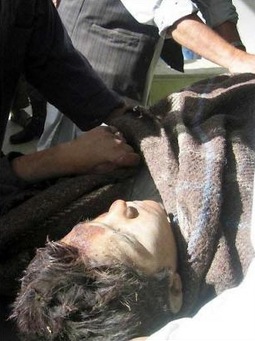
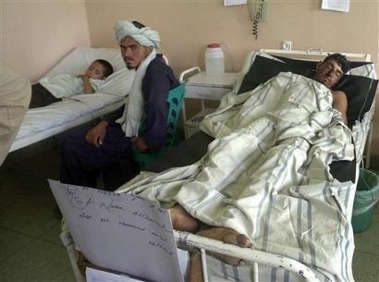
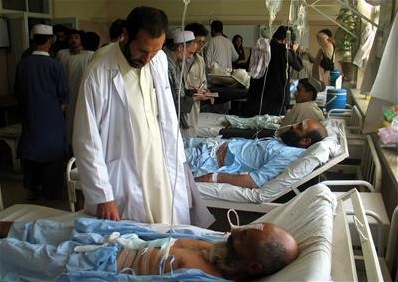
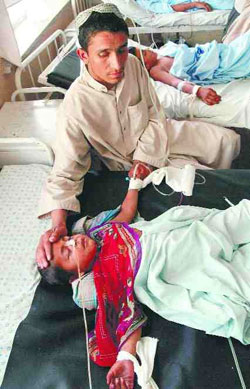
In the end, the efforts by the U.S. military and the mainstream corporate press
to manage the news failed because the bombed area could not be isolated and
contained. The brave Afghan civilians who desperately sought care in Mir Wais
Hospital were a genie which could not be put back into the "news management"
bottle. The intrepid reporting by Nasrat Shoib of Agence France-Presse
and Robert Birsel of Reuters brought their stories before the eyes
of the world in such a way that other news media were obliged to follow. The
U.S. military could stonewall no more when headlines in dailies like London's
Times and the Globe & Mail – though not the Washington
Post or the Los Angeles Times - were about civilian casualties.
By Wednesday, the headlines were no longer about dead Taliban and "precision
fire" by A-10 Warthogs.
On Tuesday, Asadullah Khalid, the governor of Kandahar province, met with many
of the wounded at the hospital and gave them cash payments, in some cases folding
the equivalent of about $450 into a barely conscious patient's hand.21
Naturally the perpetrator has offered in a pure public relations gesture, to
investigate himself while the usually bleating Karzai emits a mild reprimand
(both of which are widely reported throughout the U.S. mainstream press22).
The message to those on the couch is clear: we Americans abide by the law and
investigate possible infractions.23
A reasonable counting of the dead in the village of Hajiyan indicates between
35-40 innocent Afghan civilians perished in the hail of rocket fire by A-10
Warthogs:
Atta Mohammad, 60, says
|
24 family members killed
|
(Daad Mohammad, a boy, possibly related, says)
|
(7 family members killed)
|
Azizullah, a teenager says
|
2 brothers killed
|
Mahmood, 12, says
|
8 family members killed
|
(Taj Muhammad,sp?, related to above, says)
|
(2 brothers killed)
|
Zurmina Bibi, mother, says
|
10 family members killed
|
Abdullah, a teacher says
|
He burried 28 people
|
The world knew that Zurmina Bibi was right when, crying, she described her
village, Haijiya, that early Monday morning,
"There were dead people everywhere."
Footnotes
1. Four years ago, I wrote a similar article exploring the
attack upon a wedding in Kakarak village, Uruzgan Province. The article was
widely reprinted and may be seen in India’s foremost weekly magazine ,Frontline,
at: “The massacre
at Kakarak. Of arrogance and Pentagon-speak, in the midst of chasing Mullah
Omar's shadows and keeping Hamid Karzai in power,” Frontline,
August 16, 2002.
2. Details in my database, "A Dossier on Civilian Victims
of United States' Aerial Bombing of Afghanistan: A Comprehensive Accounting,"
available here.
3. For details on the armed conflict dynamics, see my essay
“U.S. Military
Strategy to Maintain Afghanistan as an ‘Empty Space’: The Perfect
Neo-colonial State of the 21st Century. Part Four,” Cursor.org, March
18, 2006.
4. Rachel Morarjee, “Security
Slipping around Kandahar. More than 250 people were killed in violence this
past week in Afghanistan,”, Christian Science Monitor , May
23, 2006.
5. “Taliban Commander Caught, Afghan Rebel Toll Nears
200,” Agence France Press, May 19, 2006.
6. For example by CBS News in “Key Taliban
Leader Captured?” CBS News, May 19, 2006, and Noor Khan, “General:
Militant May be Taliban Leader,” Associated Press Online, May
19, 2006.
7. See my “Uranium
Wars: The Pentagon Steps up its Use of Radioactive Munitions,” Cursor.org,
November 13, 23002.
8. “Bombs Take Heavy Toll,” Melbourne Herald
Sun, May 23, 2006.
9. On KARE-TV (Minneapolis), “U.S.
Forces Hit Taliban Enclave” dated May 22, 2006 citing a news wire
report by Noor Khan of the Associated Press.
10. Asadullah Khalid is linked with Abdul al-Rasul Sayyaf’s
political-military faction Tanzim-e Dahwat-e Islami-ye Afghanistan, formerly
known as Ittihad-e Islami-ye Afghanistan. See a photo
of Asadullah with his U.S. protectors.
11. Noor Khan (Associated Press), “Coalition
Air Strike Kills about 50 in Afghanistan,” the Globe and Mail,
May 22, 2006.
12. In Nasrat Shoib, “50
Taliban, 16 Civilians Killed in Afghanistan Air Raid,” Agence
France Presse, May 22, 2006.
13. Tim Albone, “Civilians
Die in Raid on Taliban,” Times Online , May 23, 2006.
14. “Concern
Mounts Over Civilian Deaths in Afghanistan,” Agence France Presse,
May 23, 2006.
15. “Bombs
Take Heavy Toll,” Melbourne Herald Sun, May 23, 2006.
16. Jim Farrell, “Afghan
Villagers Say Canadians must share Blame for Deadly Air Attack,”,
Edmonton Journal , May 23, 2006.
17. Bob Weber, “Air Strike Kills 80 Rebels in Southern
Afghanistan: 16 Civilians Also Die,” CBC News, May 22, 2006.
18. Bob Weber, “Air Strike Kills 80 Rebels in Southern
Afghanistan: 16 Civilians Also Die,” CBC News, May 22, 2006.
19. from Ruhullah Khapalwak, “U.S.
Airstrike at Taliban Kills Civilians, Afghans Say,”, New York
Times, May 23, 2006.
20. “US
air strike ends an Afghan mother’s world,”, Agence France
Presse, May 27, 2006.
21. Weber, op. cit.
22. As for example in “Afghan
Civilian Deaths Will be Probed to ‘Fullest,’ U.S. Says,”,
Bloomberg.com, May 24, 2006, and Carlotta Gall, “Karzai
Orders Inquiry into U.S. Airstrike,”, International Herald Tribune,
May 23, 2006.
23. The official public relations approach to civilian casualties
has a long history, see Edward S. Herman, “Tragic
Errors in U.S. Military Policy. Targeting the Civilian Population,”
Z Magazine, September 2002.

